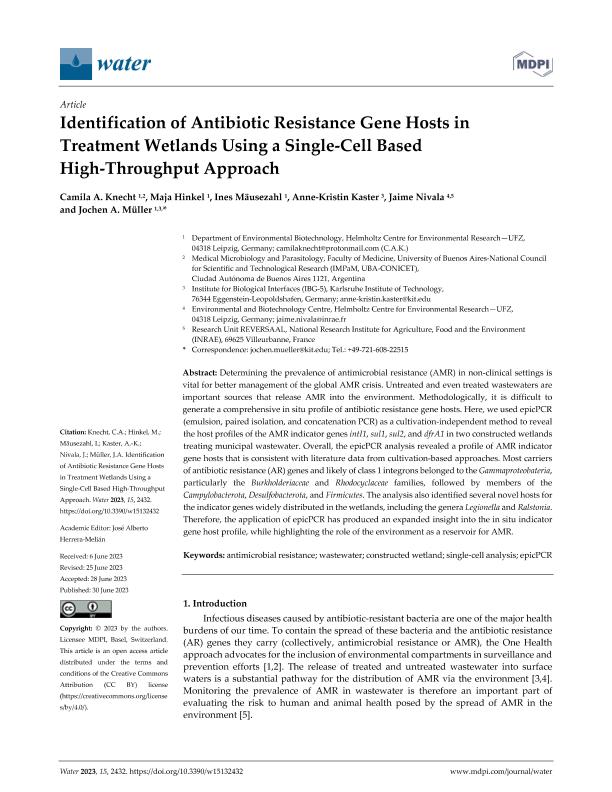Mostrar el registro sencillo del ítem
dc.contributor.author
Knecht, Camila Ayelén

dc.contributor.author
Hinkel, Maja
dc.contributor.author
Mäusezahl, Ines
dc.contributor.author
Kaster, Anne Kristin
dc.contributor.author
Nivala, Jaime
dc.contributor.author
Müller, Jochen A.
dc.date.available
2024-02-21T13:15:13Z
dc.date.issued
2023-06
dc.identifier.citation
Knecht, Camila Ayelén; Hinkel, Maja; Mäusezahl, Ines; Kaster, Anne Kristin; Nivala, Jaime; et al.; Identification of Antibiotic Resistance Gene Hosts in Treatment Wetlands Using a Single-Cell Based High-Throughput Approach; MDPI; Water; 15; 13; 6-2023; 1-16
dc.identifier.issn
2073-4441
dc.identifier.uri
http://hdl.handle.net/11336/227759
dc.description.abstract
Determining the prevalence of antimicrobial resistance (AMR) in non-clinical settings is vital for better management of the global AMR crisis. Untreated and even treated wastewaters are important sources that release AMR into the environment. Methodologically, it is difficult to generate a comprehensive in situ profile of antibiotic resistance gene hosts. Here, we used epicPCR (emulsion, paired isolation, and concatenation PCR) as a cultivation-independent method to reveal the host profiles of the AMR indicator genes intI1, sul1, sul2, and dfrA1 in two constructed wetlands treating municipal wastewater. Overall, the epicPCR analysis revealed a profile of AMR indicator gene hosts that is consistent with literature data from cultivation-based approaches. Most carriers of antibiotic resistance (AR) genes and likely of class 1 integrons belonged to the Gammaproteobateria, particularly the Burkholderiaceae and Rhodocyclaceae families, followed by members of the Campylobacterota, Desulfobacterota, and Firmicutes. The analysis also identified several novel hosts for the indicator genes widely distributed in the wetlands, including the genera Legionella and Ralstonia. Therefore, the application of epicPCR has produced an expanded insight into the in situ indicator gene host profile, while highlighting the role of the environment as a reservoir for AMR.
dc.format
application/pdf
dc.language.iso
eng
dc.publisher
MDPI
dc.rights
info:eu-repo/semantics/openAccess
dc.rights.uri
https://creativecommons.org/licenses/by/2.5/ar/
dc.subject
ANTIMICROBIAL RESISTANCE
dc.subject
CONSTRUCTED WETLAND
dc.subject
EPICPCR
dc.subject
SINGLE-CELL ANALYSIS
dc.subject
WASTEWATER
dc.subject.classification
Bioremediación, Diagnóstico Biotecnológico en Gestión Medioambiental

dc.subject.classification
Biotecnología del Medio Ambiente

dc.subject.classification
INGENIERÍAS Y TECNOLOGÍAS

dc.title
Identification of Antibiotic Resistance Gene Hosts in Treatment Wetlands Using a Single-Cell Based High-Throughput Approach
dc.type
info:eu-repo/semantics/article
dc.type
info:ar-repo/semantics/artículo
dc.type
info:eu-repo/semantics/publishedVersion
dc.date.updated
2024-02-20T12:44:56Z
dc.journal.volume
15
dc.journal.number
13
dc.journal.pagination
1-16
dc.journal.pais
Suiza

dc.description.fil
Fil: Knecht, Camila Ayelén. Consejo Nacional de Investigaciones Científicas y Técnicas. Oficina de Coordinación Administrativa Houssay. Instituto de Investigaciones en Microbiología y Parasitología Médica. Universidad de Buenos Aires. Facultad de Medicina. Instituto de Investigaciones en Microbiología y Parasitología Médica; Argentina
dc.description.fil
Fil: Hinkel, Maja. Helmholtz Centre for Environmental Research; Alemania
dc.description.fil
Fil: Mäusezahl, Ines. Helmholtz Centre for Environmental Research; Alemania
dc.description.fil
Fil: Kaster, Anne Kristin. Karlsruhe Institute of Technology; Alemania
dc.description.fil
Fil: Nivala, Jaime. Helmholtz Centre for Environmental Research; Alemania
dc.description.fil
Fil: Müller, Jochen A.. Karlsruhe Institute of Technology; Alemania
dc.journal.title
Water
dc.relation.alternativeid
info:eu-repo/semantics/altIdentifier/url/https://www.mdpi.com/2073-4441/15/13/2432
dc.relation.alternativeid
info:eu-repo/semantics/altIdentifier/doi/http://dx.doi.org/10.3390/w15132432
Archivos asociados
